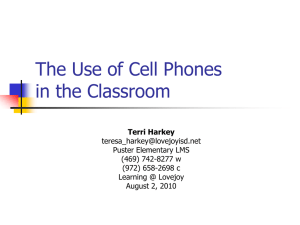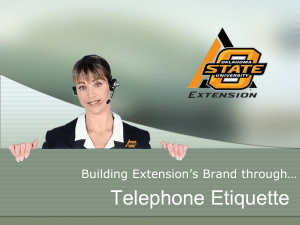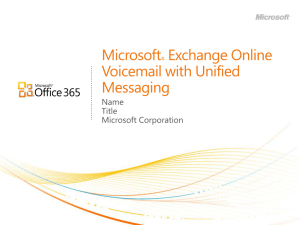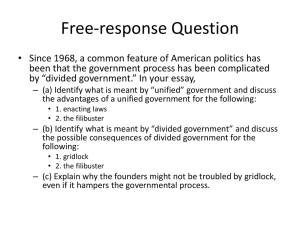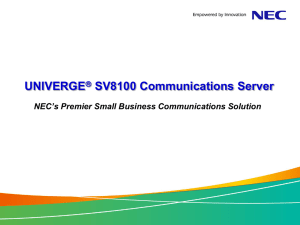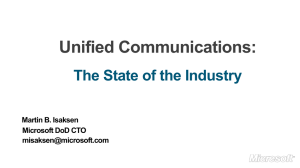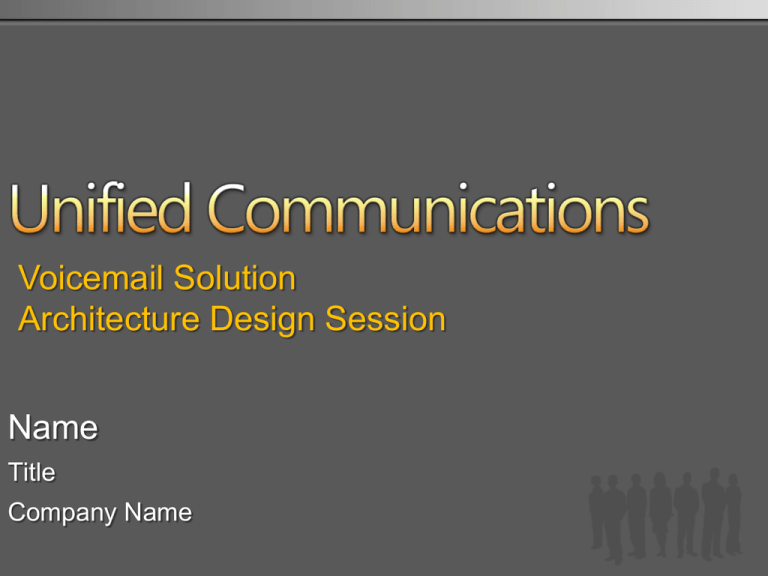
Voicemail Solution
Architecture Design Session
Name
Title
Company Name
Architecture Design Session
Solution
Briefing
Summary
Vision scope
input from
solution
briefing
Solution
Overview
Technology
Overview
VPC-based
demo
Point out
technologies
for relevant
capabilities
View the
capabilities in
action
Show various
possibilities
Discuss
technologies
Architecture
Discussion
Discuss
Architecture
Decision Points
POC
Planning
Develop scope
and
specifications
for POC
Architecture Design Session
Solution
Briefing
Summary
Vision scope
input from
solution
briefing
Summary of Pains and Drivers
Challenges
•
•
Inability to act quickly on
customer requests or internal
communications while on the
road
Time and costs required to
check separate voice mail
systems while traveling
Business Drivers
•
•
•
Meet customer requirements on
time and increase sales wins
Connect with external and
internal resources from
anywhere without
compromising productivity
Lower IT costs through
consolidation
Technical Requirements
•
•
Deliver a solution that enables interoperability with new and existing
systems
Deliver a secure unified inbox for e-mail, voice mail, calendaring, and
contacts
Architecture Design Session
Solution
Briefing
Summary
Vision scope
input from
solution
briefing
Solution
Overview
VPC-based
demo
View the
capabilities in
action
Show various
possibilities
Communications Today
Instant
Messaging (IM)
Unified Inbox
& Presence
Voice Mail
Video
Conferencing
Telephony
and
Voice Mail
User
Experienc
e
Authentication
User
E-mail and
Calendaring
Web
Conferencing
Unified
Conferencing:
Audio, Video,
Web
User
User
User
Experienc
e
Authentication
Authentication
Administration
Administration
Storage
Authentication
Administration
Storage
Audio
Conferencing
User
Experience
Experienc
e
Authentication
E-mail and
Calendaring
Instant
Messaging
Experienc
e
Administration
Storage
Telephony
Storage
User
Experienc
e
Administration
Storage
Authentication
Authentication
Administration
Administration
Storage
Compliance
On-Premises or in the Cloud
Storage
Experienc
e
Authentication
Administration
Storage
Microsoft Unified Communications
Increased productivity through communications convergence
Across Devices
PC, Mobile, Web
Increase
Efficiency and
Flexibility
Streamline
Communications
Amplify Protection
and Control
Unified Identity,
Presence, and Inbox
Authentication
Administration
Storage
Compliance
Provide a Unified
and Extensible
Platform
Maximize IT
Resources
with S+S
On-Premises or in the Cloud
Scenarios
Microsoft UC Products and Services
Conferencing
E-Mail and Security and
Calendaring Compliance
VoIP
IM and
Presence
Conferencing
Mobility
E-mail Security,
Compliance, and
Continuity
Delivery
Products
Unified
Messaging
On Premise
Hosted by Microsoft
Hosted by Microsoft or by Partners
Hosted by Partners
UC Journey Through Infrastructure
Optimization
identify
where
you want
to be
identify
where
you are
Basic
Standardized
Rationalized
Dynamic
Basic e-mail, file
shares, mostly
phone based
communication
Standard platform
for secure e-mail
and IM
Increasing
unification of
communication
channels
Ad hoc teaming
around functions &
projects based on IT
standards
Fully managed
collaboration
platform and
pervasive access
Seamless
collaboration across
the firewall
Federation of
communication
information and
policy
IT is an
Efficient cost center
IT is a
business enabler
IT is a
cost center
IT is a
strategic asset
Identifying Target Maturity Level
Voice
Conferencing
IM &
Presence
Messaging
Basic
Standardized
Rationalized
Basic email with no remote Rich mailbox & calendaring
access and with limited
Secure, remote, online &
security
offline access
Minimal or decentralized
Basic AV/AS/AP protection
IT support
and disaster recovery
User inboxes are fully
Solution supports encryption
managed by IT
Business continuity with
AS/AP and multi-layer AV
protection
Public IM/online
presence, ad-hoc use for
daily business
Secure IM/online presence
accessible from a variety of
devices and integrated into
enterprise productivity &
collaboration platform
Secure access from inside
& outside the firewall
Supports peer-to-peer voice
& video communications
Presence enabled email
client
Sporadic use of audio &
web conferencing
Limited video
conferencing capabilities
Secure web conferencing
accessible from remote
locations and devices
IT-managed video
conferencing with limited
remote access
Legacy TDM PBX,
traditional phones
Highly available hybrid
telephony infrastructure
Limited voice mail and
call routing
Online & offline access to
voice mail
Managed call routing
Support advanced policydriven message controls
Provisioning for user
inboxes
Dynamic
Seamless business continuity
with multiple AV/AS protection
Advanced policy control to
mobile devices & applications
Integration with LOB
applications
Federation of calendar
Supports federation and
integration with LOB
applications
Persistence group chat
Integrated & secure
conferencing platform
Supports high-quality audio
& video
Remotely accessible
collaboration features
Encrypted voice infrastructure
with unified inbox accessible
from PCs, phones, & web
browsers
Managed storage
Presence-based call routing
Contextual unified
conferencing solution tightly
integrated with collaboration
infrastructure and LOB
applications
Integrated voice platform for
IM/presence; conferencing
with LOB applications
Auto-remediation, proactive
monitoring of call quality
Federated identity and
presence-based call routing
Voicemail
(Unified Messaging)
Exchange Unified Messaging Solution
Organization
Consolidate
voicemail onto a
single messaging
platform
Native Message
Waiting Indicator
announces the
arrival of a new
voicemail
IT
Manage voicemail
and email systems
from a single
platform
Manage UM using
scriptable
commands and
workflows
Secure confidential
and private
voicemail
User
Read voicemail with
Voicemail Preview
Create customized
greetings and call
transfer options
Improved caller ID
Architecture Design Session
Solution
Briefing
Summary
Vision scope
input from
solution
briefing
Solution
Overview
Technology
Overview
VPC-based
demo
Point out
technologies
for relevant
capabilities
View the
capabilities in
action
Show various
possibilities
Discuss
technologies
Technology Overview
Exchange Server 2010 Unified Messaging
Call answering (Outlook, Outlook Web App)
Outlook Voice Access (E-mail, VM, calendar, contacts)
Rich Fax Partner Support
Automated Attendant
Lync Server 2010
Remote Call Control
Forward calls to voice mail based caller ID pop up
Use Lync 2010 to direct voicemail playback
Make voice calls through the PBX
Message indicator icon in Lync 2010
Exchange Unified Messaging
Voicemail in Your Inbox
Extend the Exchange Server vision by
bringing voicemail to the inbox
Simplify tasks and reduce
administrative costs by consolidating
infrastructure and training
Expand the reach of Exchange to the
telephone to allow “anywhere access”
to your inbox, calendar, and contacts
Exchange Unified Messaging
Benefits
Key User Benefits
Access to Exchange Information
Play on Phone
Voice mail form
User end configuration
Call Answering
Call answering Rules
Voice Mail Preview
Missed call and voice mail
notifications using SMS
Protected Voice Mail
Outlook Voice Access
Group addressing using Outlook
Voice Access
Key Admin Benefits
A complete unified messaging
system
An Exchange 2010
deployment and administration
model
An Exchange 2010 security
model
Consolidation of voice mail
systems
Built-in Unified Messaging
administrative roles
Incoming fax support
Support for multiple languages
Auto attendant
Exchange Unified Messaging
Triage voice messages quickly
Voicemail Preview
Save time and money by triaging
voicemail in your inbox by reading the
text preview
Available in U.S. English, Canadian
English, French, Portuguese, Italian,
Polish, Spanish
Inline Audio
Playback
Text Preview
of Voicemail
Contextual
Actions
Exchange Unified Messaging
Call Answering Rules
Call Answering Rules
As simple as email Inbox Rules
Provide different menu choices based on the
Caller ID
Manage Rules
Define a
Personalized
Voicemail Menu
Exchange Unified Messaging
Call Answering Rules Improvements
In the RTM version, Call
Answering Rules required a
caller to explicitly select an
option. If no option was
selected, UM would time out
after 10 seconds, and then
prompt the caller again for
input. In SP1, the time-out
value is changed to 5
seconds, and the caller is
prompted with "To leave a
voice message, press the
pound key or wait for the
tone." Then, if the caller
doesn't press a key, the UM
server will prompt the caller
to record a voice mail
message instead of waiting
for them to press a key.
In the RTM version, when
a caller who's greeted by
a call answering rule
selects the voice mail
option, a UM server first
plays the called party's
voice mail greeting before
prompting the caller with
the instruction to leave a
voice message. This can
be confusing if the user
has created custom
greetings. In SP1, the
voice mail greeting is
skipped if the caller has
chosen to leave a voice
message via a call
answering rule that's
configured.
In SP1, a
missed call
notification
won't be left
for a user if
the inbound
call reaches
the called
party using
the Find Me
feature, if a
call transfer
succeeds, or
if a voice
message is
successfully
left for the
user.
Exchange Unified Messaging
Caller ID lookup
Resolves caller ID to a contact’s name
whenever possible
Unified Messaging (UM) uses information about the
calling and called parties to perform a name lookup.
This lookup enables a caller's name to be included:
In a missed call notification
When a caller leaves a voice message for a UM-enabled user
when the calling party's name is located in Active Directory or
in the called party's personal Contacts.
Support for enhanced caller ID resolution for displaying
names for voice mails from unresolved numbers using
Caller Name Display (CND)
Exchange Unified Messaging
Options for Playing Voice Messages
Play on your Computer, Over the Telephone, Or Add Audio
Notes
Inline Audio
Playback
Exchange Unified Messaging
Protected Voicemail – Prevent forwarding of
voicemail
Protect All messages or
only messages marked
Private by sender
“Do Not Forward”
template
Integration with AD RMS and Exchange Unified Messaging
Permissions designated by sender (by marking the message as private)
or by administrative policy
Exchange Unified Messaging
Message Waiting Indicator - Be notified when you
have a new voicemail
Phone
Gateway
& PBX
UM
servers
Mailbox
servers
Exchange 2010 UM supports MWI natively
Configure through UM Mailbox Policy
No new roles
Highly scalable
Also can send SMS to mobile phone with first 160 characters of
Voicemail Preview
Exchange Unified Messaging
Auto Attendant
Provides a voice menu system to locate and place
or transfer calls
One or more Auto Attendants can be configured and
deployed as required
Supports multiple languages
Customizable to meet organizational requirements
Speech-access or DTMF interface
Access to individuals and/or departments
Exchange Unified Messaging
Auto Attendant – An example
Exchange Unified Messaging
Outlook Voice Access
Enables users to retrieve e-mail messages from their
mailbox using an Analog, Digital or Mobile telephone
Users can interact with their mailbox
using touchtone or voice commands
Automatic Speech Recognition
(ASR)
Users can retrieve, listen to, reply to,
create, and forward voice or e-mail
messages
Listen to or change calendar
information
Send a voice message to a personal
contact
Can set personal greeting messages
Allows user to choose the order to
listen to unread voice mail
messages, from the oldest message
first or the newest message first
Listening to e-mail messages using the
Voice User Interface
Sending an I'll be late message using
the Voice User Interface
Sending an I'll be late message using
the touchtone interface
Exchange Unified Messaging
Allows two extension numbers to a UM-enabled
user
You can add a secondary UM dial plan for a UMenabled user. Secondary dial plans allow
administrators to assign two extension numbers to a
UM-enabled user. Or, you can assign a primary
extension number in a UM-enabled user's primary dial
plan on one PBX or IPX PBX and a secondary
extension for that user within a secondary dial plan that
exists on a different PBX or IP PBX.
Exchange Unified Messaging
Rich Fax Partner Support
Integrated Experience
Fax messages appear to the user in a familiar fashion
Administration is done in EMC for provisioning and deprovisioning
Partner Interoperability Program
Fax specification is published and available to all partners
who wish to have a first-class integration
TekVizion is the certification partner
Flexibility and Security
Partner connections are authenticated by Exchange
Choice of hosted or on-premises partners
Exchange Unified Messaging
International Support - Prompts, text-to-speech,
speech recognition
Catalan
Chinese (Hong
Kong)
Chinese (PRC)
Chinese
(Taiwan)
Danish
Dutch
Australia
Canada
GB
India
United States
Finnish
French
English
Canada
France
German
Italian
Japanese
Norwegian
Polish
Korean
Portuguese
Brazil
Portugal
Russian
Spanish
Spain
Mexico
Swedish
Exchange Unified Messaging
Voice Mail Retention for Compliance
Voice mail needs
to be retained and
discoverable
Built-in compliance
options with
Exchange 2010
Built-in compliance
options with OCS
2007 R2
Exchange Unified Messaging
UM Administrative Experience - New Role-based
Access Control
Three UM administrative roles, as shipped
UM Administrator
Administer any and all UM functionality
UM Recipient Administrator
Provision UM mailbox, PIN reset, clear lockout
UM Prompt Administrator
Update Dial Plan and/or Auto Attendant prompts
Custom roles may be created
Exchange Unified Messaging
User end configuration
Outlook Web App provides UM enabled users to
configure options for Voice mail, OVA, and Call
Answering Rules
Exchange Unified Messaging
Enterprise-class reliability
UM protocols:
SIP/RTP to gateway/PBX
LDAP to the directory
MAPI/RPC to mailboxes
Can place UM servers distant
from PBXs
Support scale out and server
consolidation
Exchange Unified Messaging
Regulatory Controls - Flexibility to meet business
needs
New-ManagedContentSettings
-MessageClass IPM.NOTE.Microsoft.Voicemail*
-Name "Voice Mail Retention Period"
-AgeLimitForRetention "30"
Greater control of
voicemail
Voicemail in your Inbox
Reduces the cost of
accessing, querying,
and producing voicemail
Option for standalone
voicemail
-foldername "Inbox"
-RetentionAction "PermanentlyDelete"
-RetentionEnabled $true
Single administration point
Powerful retention policies
can be applied
Lync Server 2010
Beyond Unified Messaging
Presence infrastructure
Use Lync 2010 and Lync Mobile as client end-points
Provide presence to enabled applications
Easily embed presence information in custom applications
Instant messaging
Collaboration and conferencing
Voice, video, presentations, application viewing/sharing
Ad-hoc or scheduled
Promote and demote as needed
Software-powered VoIP integration
Works with legacy PBXs
Works with VoIP implementations
Integrates with PSTN
Lync Sever
Remote Call control
Users get a consistent rich experience bringing voice to the PC regardless of infrastructure
Integrate with existing infrastructure, whether TDM or IP-based
On PC call control; caller ID, call forwarding, voice mail play back, send call to voice mail, voice mail
notification
One click access to voice mail via Lync, no need for a PIN
Lync Server Deployment
IP-PBX
PBX
VoIP Gateway
PBX Phone
PSTN
PBX Phone
Better Together with Lync 2010
Message Waiting Indicator (MWI) in
Lync 2010 and UC devices
Direct dial into Outlook Voice Access
without reentering PIN
Voice mail is recorded in higher
quality than traditional voice mail
Voice Mail Preview
Missed call and forwarded call
notifications in inbox
Exchange 2010 and Lync Server 2010
Unified Messaging integration
With one click, switch to the
voice mail message
Missed call notifications
Inbound Call can be
forwarded to another
number or to Voice Mail
Support for recording highfidelity voice mails
Direct voicemail calling
Outlook Voice Access
Assign subjects and
priorities
Auto Attendant
Architecture Design Session
Solution
Briefing
Summary
Vision scope
input from
solution
briefing
Solution
Overview
Technology
Overview
VPC-based
demo
Point out
technologies
for relevant
capabilities
View the
capabilities in
action
Show various
possibilities
Discuss
technologies
Architecture
Discussion
Discuss
Architecture
Decision Points
Key Deployment Scenarios
Small, Medium and distributed business
Consider voice recognition functionality in Exchange and how it can be used for auto attendant, teleprompt,
company directory, and inbox access
Evaluate current phone system requirements to support Exchange UM
Consider different government impacts if you cross boarders
Highly mobile organizations
Consider remote access network requirements
Evaluate your PKI certificate options to support secure remote access
Companies facing end-of-life situations for current voice mail solutions
Evaluate current phone system requirements to support Exchange UM
Determine needed feature sets for future phone system
Exchange Unified Messaging
A close relationship with telephony
Exchange Unified Messaging topology
with single PBX
Exchange Unified Messaging topology
with multiple PBXs
Exchange UM and Lync Server 2010
Connectivity
Phone Company’s Central
Office
Client Access
Lync
Client
Mailbox
Lync Server Pool
Gateway
Unified Messaging
Lync Phone Edition
External Phone
Hub Transport
Active Directory
Exchange UM Architecture
TDM
SIP/RTP
LDAP
PSTN
Phone
IP PBX
AD DS
SMTP
Partner Fax
TDM
Fax
PBX
VoIP
Gateway
RPC
Hub Transport
Server
SIP
Phone
TDM
VoIP
Gateway
Client Access
Server
Mediation
Server
Lync FrontEnd
Server
Internet
Edge/Firewall
HTTPS
PBX
Phone
RTP
Unified Messaging
Server
RPC/HTTPS
Phone
Computer
Exchange
ActiveSync
Outlook Web
Access
Outlook
Mailbox
Server
UM Server Role Requirements
UM Requires Mailbox, Hub Transport and UM server
roles
Server should be placed in the protected corporate
network
SIP connectivity between the UM server and the PBX
is required
Traditional PBX requires gateway
Many VoIP PBX also require gateway
“UM ready” VoIP PBX systems connect natively
Exchange Enterprise CAL required for client VM
access
Architecture Decision Points
Current
Infrastructure
• Current UM technologies
Future
Infrastructure
• Future UM needs and goals
Anywhere Access
• Basic access requirements
Deployment
• Basic deployment planning
Architecture Decision Points
Current Infrastructure
What PBX systems are you now using?
Used to determine type of gateway needed to integrate with UM
What technologies are currently implemented that offer UM?
What is the current network and office topology?
What are the company drivers and requirements for UM?
What media gateway resources will be required?
Given your scenario, what requirements will you have for
Voice mail
Inbound and outbound call routing
Call restriction
Call detail reporting
Architecture Decision Points
Future Infrastructure
What are the future plans for the network and office
topology?
What are the expansion expectations for the next six
months, a year, two years, and five years?
What types of UM solutions are needed?
Does everyone need the same type?
Which specific services or resources do you want to
provide access to?
Architecture Decision Points
Anywhere Access
What certificate types will be required and how will they
be deployed?
Outlook Voice Access requires an inbound extension to
Exchange Server – Determine the type of number
needed
What other servers will have proxy access provided by
Exchange Server?
Will you need custom prompts or recordings made for
Exchange
Architecture Decision Points
Deployment
Do you need to deploy any PKI assets if you’re just doing
a pilot?
Consider Lync as part of your UM deployment to give
users more control.
Coordinate with network security / firewall team to
provide appropriate tunneling, server access, and server
placement.
Determine the type of gateway or PBX software needed
to allow Exchange and the PBX to interact
Determine the Fax Partner Solution for Fax services
Will there be a migration path from the old system to the
new – How will users be retrained?
Architecture Design Session
Solution
Briefing
Summary
Vision scope
input from
solution
briefing
Solution
Overview
Technology
Overview
VPC-based
demo
Point out
technologies
for relevant
capabilities
View the
capabilities in
action
Show various
possibilities
Discuss
technologies
Architecture
Discussion
Discuss
Architecture
Decision Points
POC
Planning
Develop scope
and
specifications
for POC
POC Planning
Sponsor Name
Project Timing
Goals and Objectives
Scope
Milestones
Risks & Dependencies
Next Steps
Solution
Development
Solution
Briefing
Architecture
Design
Session
Proof of
Concept
Proof of Concept
•Assemble resources from the business
side and from the IT group
•Understand business processes that are
being addressed
•Gain knowledge about technology
infrastructure
•Verify the technology roadmap
•Review the POC scope and assumptions
© 2007 Microsoft Corporation. All rights reserved.
This presentation is for informational purposes only. Microsoft makes no warranties, express or implied, in this summary.
Appendix Slides…
Migration from Exchange 2007
•
UM 2010 requires mailbox, transport 2010
Unified Messaging version
Mailbox version
2010 2007 SP2
2007 SP2
•
UM “just works” for the enabled
users.
Not supported. Require at least one
UM 2010 server in the Dial Plan.
2010
Call answer: 302 (redirect on INVITE) to UM
2007 server in the Dial Plan
Outlook Voice Access: REFER (with context)
to UM 2007 server in Dial Plan
UM “just works” for the enabled users.
Configure IP GWs to send calls to UM 2010
−
−
OCS requires new UM Dial Plan (new pilot #)
UM-disable, enable (PIN reset) in new DP
Calculation Requirements
•
CPU-intensive: affects UM
scalability
− Throttled: UM will skip
transcription if too busy
− Estimate ~1 VM/min/core
as throughput
•
Try to use all cores
− Below normal priority
− Transcription followed by:
•
Transcoding of audio
− Creation of message
− Submission to Hub
Caller ID Lookup Improvements
•
•
Failure to resolve caller ID to a name is a major source of
complaint by end users
Numbering plan split across UM Dial Plans
− Added EquivalentDialPlanPhoneContexts on DP
−
•
FQDNs of other DPs in same numbering plan
Many non UM-enabled users have more than one phone number
− msRTCSIP-Line is not multivalued
− Added UMCallingLineIds to User object
Caller ID Lookup Improvements
•
Extension of CLID to E.164 was inflexible
− InternationalNumberFormat single-valued
− Added NumberingPlanFormats on DP
−
•
One or more patterns to extend N-digit to E.164
Lookup did not use unindexed AD attributes
− telephoneNumber, homePhone, mobile
−
−
•
UM can now generate suffix search fields
AllowHeuristicADCallingLineIDResolution on DP
Bottom line: Caller ID lookup is now better!
Configuration
•
•
•
Objects represent the telephony system and its relationships with
Exchange and its users
Exchange Server UM objects include:
− UM Dial Plan
− UM IP Gateway
− UM Hunt Group
− UM Server
− UM Mailbox Policy
− UM Auto Attendant
PowerShell cmdlets
− New-UMDialPlan
− Enable-UMMailbox
UM Dial Plan Object
•
•
•
Basic unit of Unified Messaging
system administration in Exchange
Represents the telephony extension
numbering plan
− Users in a Dial Plan can reach all
others in same Dial Plan using
fixed length extension numbers
− Extensions are unique in a Dial
Plan
− Dial Plans may be overlaid on
PBX networks that are featuretransparent
(Extension ; Dial Plan) uniquely
identifies each UM user
IP Gateway & Hunt Group Object
•
•
UM IP Gateway object
− VoIP gateway, with IP address/FQDN,
from which UM Server can receive
calls
− SIP-capable IP PBX (SIP Peer)
− UM Test Phone (Web download)
UM Hunt Group object
− Hunt group configured at a PBX that
directs calls to a VoIP Gateway
− Identified by a pilot number
− Logical link between UM IP Gateway
and UM Dial Plan
− One or more Hunt Groups per IP
Gateway
UM Server Object
•
UM Server object
− Represents UM-specific
properties on an Exchange
Server machine running the UM
role
− Communicates with one or more
IP Gateways
− Multiple concurrent calls
− Can host multiple languages
− Can be in one or more Dial Plans
− Pilot number at which
inbound call arrives identifies
Dial Plan
Mailbox Policy & Auto Attendant
•
•
UM Mailbox Policy objects
− Associated with UM Dial Plan
− Properties (such as minimum PIN length,
dialing restrictions) that apply to groups of UM
users
UM Auto Attendant objects (optional)
− Associated with UM Dial Plan
− Customizable
− Speech access or DTMF single-digit menu
−
−
−
−
−
−
−
−
Transfer call
Go to AA (multi-level menus)
Play audio
Contact scope
−
Dial Plan, Global Address List, or custom
Address List
Custom prompts
Language
Time Zone
Schedules for business hours, holidays
PBX On-premise, UM hosted
Mid-to-large companies own PBXs, but may want
Exchange and UM to be hosted
Public network between PBX and UM
Need Session Border Controllers (SBCs)
PSTN
Customer Premise
Exchange/UM
TDM
TDM
PBX
Gateway/
SBC
VoIP
Public Network
UM Call Answering With a VoIP Gateway
Step 1
Step 3
Step 2
Step 5
Step 4
Step 6
UM Call Answering Without a VoIP Gateway
Step 1
Step 2
Step 4
Step 3
Step 5
Outlook Voice Access to Unified Messaging
Step 2
Step 3
Step 1
Step 4
Codec Support
MP3 (codec and file format) is now the default for
recording voice messages
Socializes more easily with non-Windows and
non-Windows Mobile mail clients
G.711
MP3
WMA 2
GSM
WMA 9
Outlook Voice Access with Speech
Outlook Voice Access with DTMF




